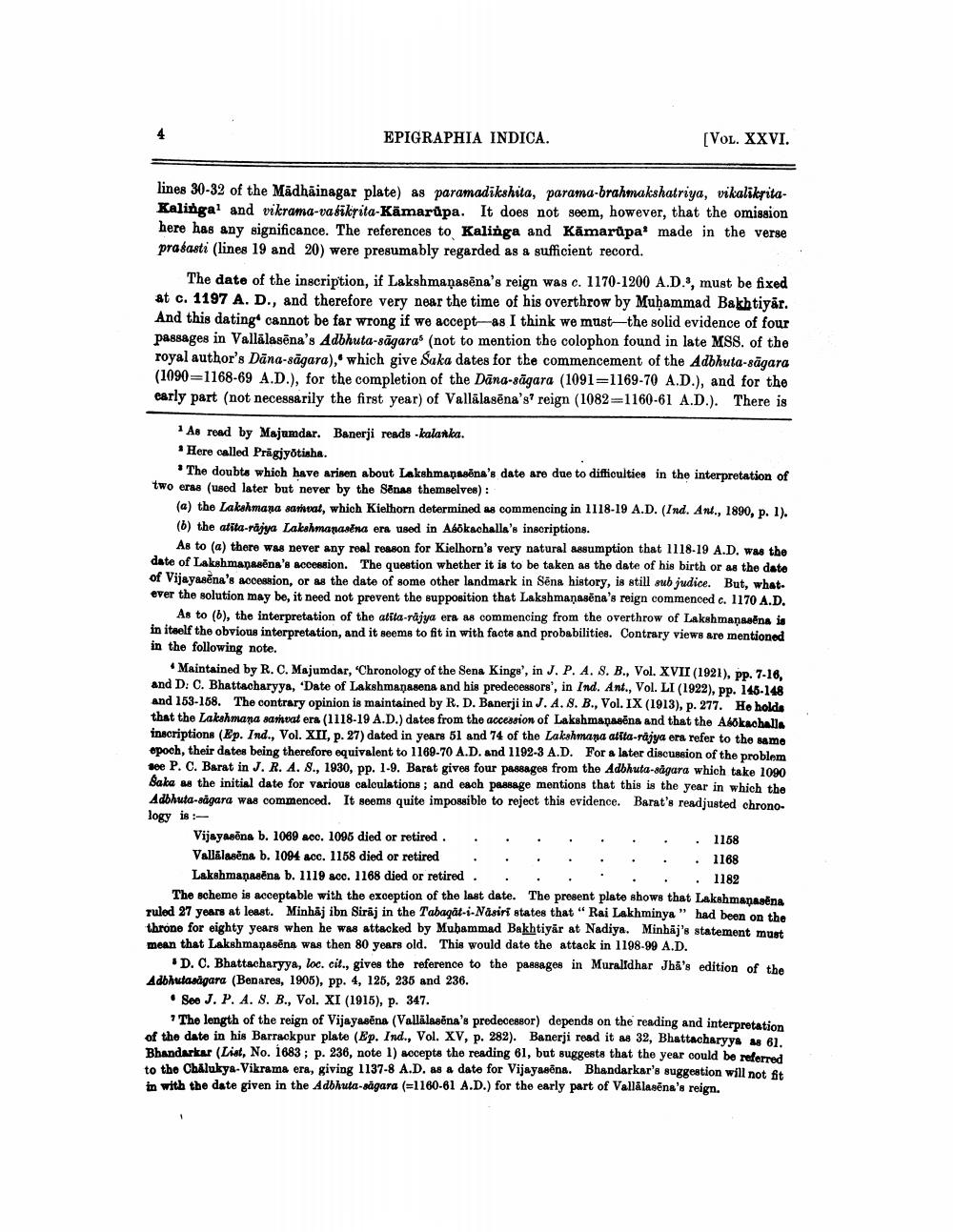________________
EPIGRAPHIA INDICA.
[VOL. XXVI.
lines 30-32 of the Mädhäinagar plate) as paramadikshita, parama-brahmakshatriya, vikalikritaKalingal and vikrama-va fikrita-Kämarupa. It does not seem, however, that the omission here has any significance. The references to Kalinga and Kāmarüpamade in the verse prasasti (lines 19 and 20) were presumably regarded as a sufficient record.
The date of the inscription, if Lakshmaņasēna's reign was c. 1170-1200 A.D., must be fixed at c. 1197 A. D., and therefore very near the time of his overthrow by Muhammad Bakhtiyar. And this dating cannot be far wrong if we accept as I think we must the solid evidence of four passages in Vallalasēna's Adbhuta-sāgaras (not to mention the colophon found in late MSS. of the royal author's Dāna-sāgara), which give Saka dates for the commencement of the Adbhuta-sägara (1090-1168-69 A.D.), for the completion of the Dāna-sägara (1091-1169-70 A.D.), and for the carly part (not necessarily the first year) of Vallalasēna's reign (10821160-61 A.D.). There is
1 As read by Majumdar. Banerji reads -kalanka. * Here called Prāgiyotinha.
The doubts which have arisen about Lakshmanasēna's date are due to difficulties in the interpretation of two eras (used later but never by the Senas themselves) :
(a) the Lakshmana sanoat, which Kielhorn determined as commencing in 1118-19 A.D. (Ind. An., 1890, p. 1). (b) the atita-rajya Lakshmarasina era used in Asökachalla's inscriptions.
As to (a) there was never any real reason for Kielhorn's very natural assumption that 1118-19 A.D. was the date of Lakshmanasēna's accession. The question whether it is to be taken as the date of his birth or as the date of Vijayasēna's accession, or as the date of some other landmark in Séna history, is still sub judice. But, what. ever the solution may be, it need not prevent the supposition that Lakshmanasena's reign commenced c. 1170 A.D.
As to (6), the interpretation of the atita rajya era as commencing from the overthrow of Lakshmansečna ia in itself the obvious interpretation, and it seems to fit in with facts and probabilities. Contrary views are mentioned in the following note.
• Maintained by R.C. Majumdar, "Chronology of the Sena Kings', in J. P. A. 8. B., Vol. XVII (1921), pp. 7-16. and D. C. Bhattacharyya, 'Date of Lakshmanasena and his predecessors', in Ind. Ant., Vol. LI (1922), pp. 145-148 and 153-158. The contrary opinion is maintained by R. D. Banerji in J. A. 8. B., Vol. IX (1913), p. 277. He holde that the Lakshmana sanoaters (1118-19 A.D.) dates from the accession of Lakshmapasēns and that the Abbkachella inscriptions (Ep. Ind., Vol. XII, p. 27) dated in years 51 and 74 of the Lakshmana afsta-rajya era refer to the samo epoch, their dates being therefore equivalent to 1169-70 A.D. and 1192-3 A.D. For a later discussion of the problem see P. C. Barat in J. R. A. 8., 1930, pp. 1-9. Barat gives four passages from the Adbhuta-sågara which take 1090 Saka as the initial date for various caloulations; and each passage mentions that this is the year in which the Adbhuta-sagara was commenced. It seems quite impossible to reject this evidence. Barat's readjusted chronology is :
Vijayasõna b. 1069 aco, 1006 died or retired . . . . . . . . 1158 Vallalasēna b. 1094 acc. 1168 died or retired . . . . . . . . 1168
Lakshmanasēna b. 1119 acc. 1168 died or retired . . . . . . . . 1182
The scheme is acceptable with the exception of the last date. The present plate shows that Lakshmanaa na Tuled 27 years at least. Minbaj ibn Sirkj in the Tabaqat-i-Nasiri states that " Rai Lakhminya" had been on the throne for eighty years when he was attacked by Muhammad Bakhtiyar at Nadiya. Minhaj's statement must mean that Lakshmaņasēna was then 80 years old. This would date the attack in 1198-99 A.D.
D. C. Bhattacharyya, loc. cit., gives the reference to the passages in Muralidhar Jha's edition of the Adbhutasagara (Benares, 1905), pp. 4, 125, 235 and 236.
• See J. P. A. 8. B., Vol. XI (1915), p. 347.
* The length of the reign of Vijayasēna (Vallalasēna's predecessor) depends on the reading and interpretation of the date in his Barrackpur plate (Ep. Ind., Vol. XV, p. 282). Banerji read it as 32, Bhattacharyys as 61. Bhandarkar (List, No. 1683; p. 236, note 1) accepts the reading 61, but suggests that the year could be referred to the Chalukya Vikrama era, giving 1137-8 A.D. as a date for Vijayaana. Bhandarkar's suggestion will not fit in with the date given in the Adbhuta-sagara (=1160-61 A.D.) for the early part of Vallalasēna's reign.




